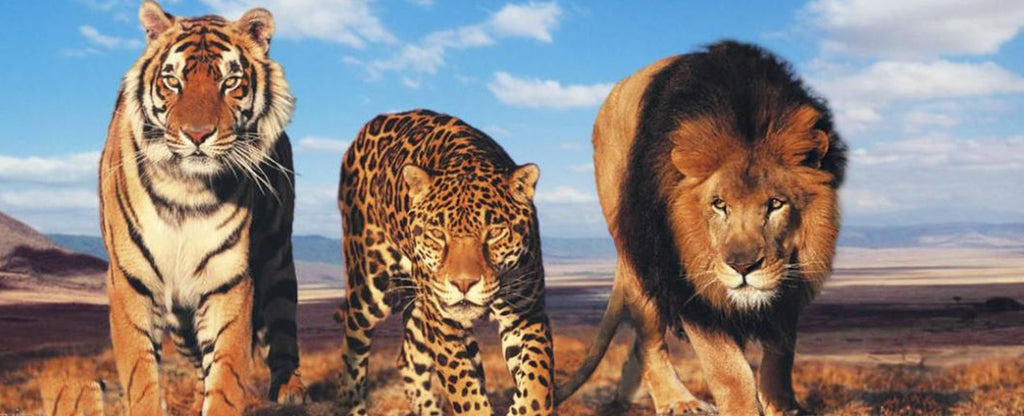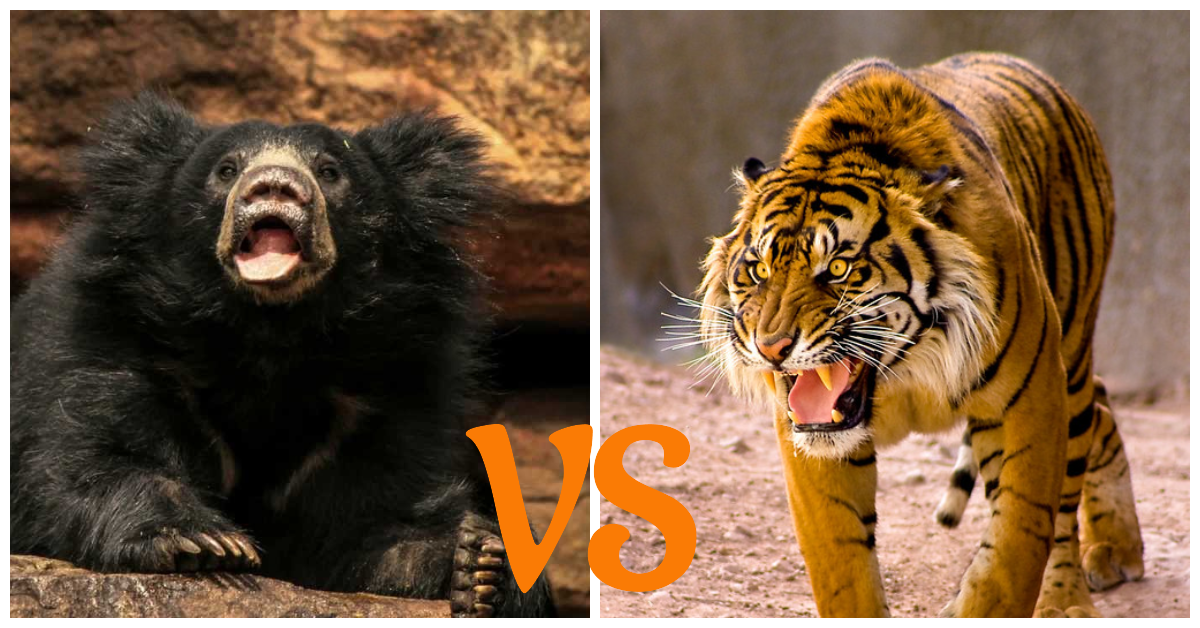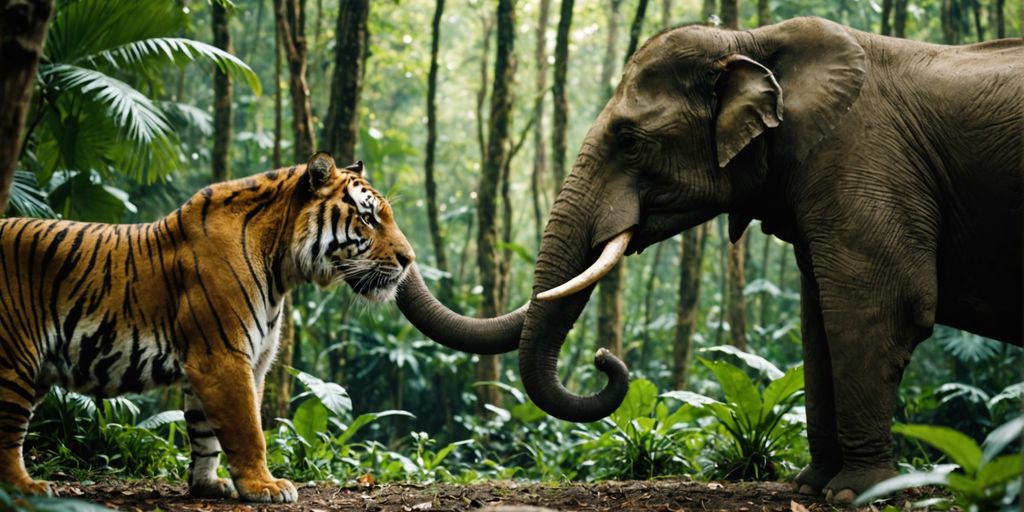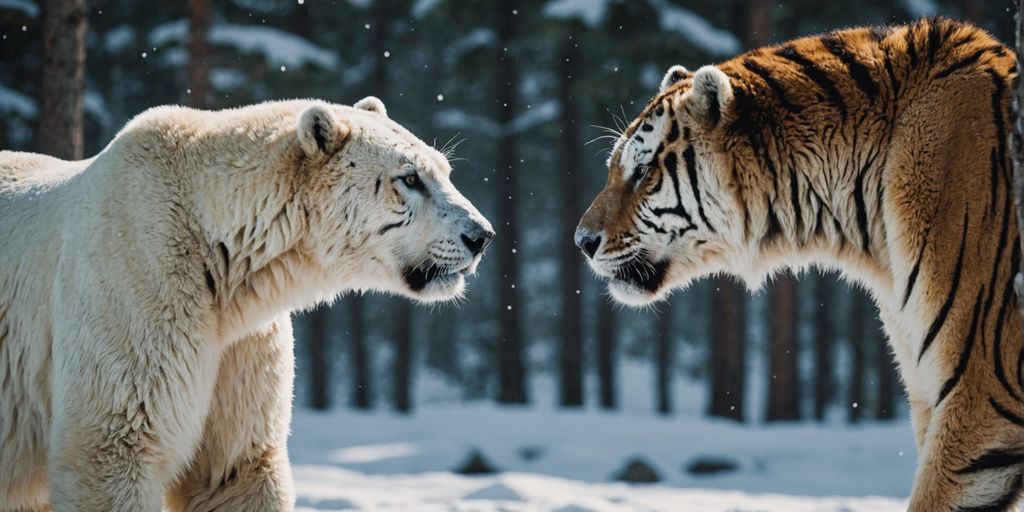Your Cart is Empty
🙏HELP US SAVE TIGERS!🐅 WE DONATE 1% OF OUR SALES TO WILDLIFE ORGANIZATIONS ( WWF ...)
Menu

🙏HELP US SAVE TIGERS!🐅 WE DONATE 1% OF OUR SALES TO WILDLIFE ORGANIZATIONS ( WWF ...)
The Felines Family
May 28, 2021 11 min read

Do you know what the Tiger, the Lion, the Panther, and even the Cat have in common? As different as they may seem, these animals all belong to the same big family: the feline family! Among the latter, there are many beasts, each more magnificent than the other.
However, if you are here, you want to learn a little more about the species that form this beautiful family. The feline group undoubtedly includes creatures you don't even know exist.
In this article, you will learn how to recognize for sure the felines that populate our beautiful planet. Beyond that, you will see the life and the so particular behavior that they adopt and characterize them so much!
At Tiger-Universe, we believe that it is essential to know this group of animals that has conquered the five continents over time. That's why we have written this report with the highest possible care and precision.
Let's not talk anymore and, if you wish, let's start this journey to the heart of the land of the cats!
The List of all Felines
1) The Small Felines
THE DOMESTIC CAT

It is undoubtedly the most famous of the felines, and for a good reason, it is almost part of our family!
Indeed, the Cat has succeeded in imposing itself as the pet of the French. This is partly due to their super cute physique, the tenderness he shows, as well as to his great cleanliness.
Today, there are more than 50 different species of domestic cats, offering us a great variety of colors in their coat. These little balls of hair can be found on all five continents that make up our beautiful planet, even if the places where they increase the most are mainly in Europe and Asia.
Finally, although Man has domesticated the Cat, it does not forget its predatory instinct. Even if it does not represent a real threat with its small size, it is advisable all the same respect this small predator which, when it wishes it, knows how to be aggressive!
THE GOAT

The Cheetah is neither more nor less than the fastest land animals, nothing less!
With its slim silhouette and its slender appearance, the Cheetah can reach speeds of up to 120km/h. This unique ability allows it to catch any prey quickly.
The coat of this feline is composed of black spots more or less large on a beige background. This camouflage is tailor-made so that it can blend in with its environment. Because the Cheetah resides mainly in Central Africa and South Africa, these very arid areas composed of vast expanses as far as the eye can see are perfect for the Cheetah!
THE PUMA

Also called Cougar in the common language, the Puma is above all a mountain feline. Among all the species that make up the feline family, it is one of the few to have a coat of solid color. Its fur varies between brown and grayish tones depending on the areas it inhabits.
By the way, where does the Puma live?
Well, chances are you'll be surprised because it lives exclusively in the Americas. It can be found on the entire continent of South America and only a part of North America. As you can see, the Puma can adapt to very different environments, ranging from the snowy mountains of the Andes to the tropical regions of Central America.
This atypical predator is still too little known in Europe, even though its beauty and character are admirable!
THE LYNX

Apart from the domestic cat, the Lynx is the only animal to exist in the wild in France. It is very recognizable thanks to its pointed ears decorated with a tuft of black hair and its very developed back legs.
We find this animal in the east of France, as we told you, and in North America and more commonly in Central Asia. With a weight painfully reaching 30 kilos for the Northern Lynx, the latter is not very imposing. Therefore, it usually attacks small prey such as birds or deer.
This small predator is, like most felines, a solitary and very territorial animal. It spends most of its time wandering around its land, searching for potential prey.
Fortunately, the Lynx is not currently threatened with extinction, just like the subsequent little feline that we will introduce to you right now!
THE CARACAL

Often wrongly considered as a Lynx, the Caracal is indeed a species in its own right. However, the resemblance with its cousin is undeniable, especially when you look at the ears of the two animals. Because in addition to being quite frail, the Caracal has large pointed ears and black color.
However, the common points stop there because the latter has a plain coat, unlike the Lynx. Moreover, it is found almost everywhere on the African continent and more rarely in South West Asia. It evolves in a scorching environment, which pushes it to hunt at night or dawn to not suffer too much from high temperatures.
Because of its small size, the Caracal does not reign supreme on its territory and can be the target of predators larger than him. It is the case with the Lion or the Leopard; both have a common the fact that they belong to the big cat sub-family!
Please continue reading to learn more about the giant predators of our time. But before you do, we suggest you take a look at our latest Fawns & Feline Painting!
2) The Big Cats
THE LEOPARD

Becoming popular thanks to its spotted camouflage, the Leopard is an excellent source of inspiration for fashion brands worldwide. Besides that, it remains one of the most fearsome and clever felines in existence. From its ability to climb to the top of trees, it draws all its strength. Being an excellent climber, the Leopard can prepare dazzling attacks straight from the sky!
Its spotted coat under a beige background allows it to become almost invisible to its future prey. The Leopard lives mainly in Central Africa, but it is possible to find it in India and, more generally, in South Asia. It particularly loves forests, but this does not prevent it from evolving in mountainous areas and even in the savannah.
Compared to the other big cats, the Leopard is not physically good. With an average weight of 60 kilos for a male, one could even believe that a man could compete with him. But to think that is to underestimate the spotted feline's strength significantly!
The latter is equipped with a powerful jaw capable of lifting a carcass of nearly 150 kilos to bring it into the trees, that is to say, almost three times its weight! Moreover, leopard attacks on humans are not rare, but what is rarer are the times when humans are victorious!
THE JAGUAR

Here is an animal that is still too often confused with the Leopard: the Jaguar!
This big cat native to South and Latin America is very similar to its cousin described above. Its spotted coat is the reason, but there are ways to differentiate them.
First of all, the Jaguar is heavier and has a much more massive appearance than the Leopard. Furthermore, it is not as good a climber as its cousin and will always prefer dry land or water. Finally, their coat is not the same because the Jaguar spots are generally more oversized, darker, and less numerous than their counterparts.
But if you had to remember only one thing about this American feline, it is its devastating bite!
Considered by many to be the most powerful bite of all felines, it can pierce the shell of a turtle. The Jaguar uses this strength to hunt in a very particular way. Contrary to other cats, the Jaguar uses its powerful jaw to bite its victims directly in the skull, killing them on the spot by crushing their brains.
This killing is unique in the animal kingdom, and that's why you must know it!
If you ask yourself about if a Jaguar is powerful and agile enough to get rid of a tiger, go check our blog post: Can a jaguar kill a tiger?
THE PANTHER

At the risk of disappointing you, we are obliged to inform you that the Panther is neither more nor less than a Leopard. It is a common misconception that the Panther is a species in its own right.
So, where does the word Panther come from?
Originally, the name was used to identify better the subspecies of Leopard, including the famous Black Panther. It was misunderstood by the scientific community so that today many people think that the Panther is a very different animal from the Leopard.
We hope you will not make a mistake again when you see a "Black Panther"!
THE LION

We now turn to what many people consider the king of animals and the most potent felines: the Lion!
Recognizable by his large mane that he wears proudly as an ornament, the male Lion is the ultimate super-predator of Africa. He lives almost exclusively in the savannah, an environment that gives him an advantage when hunting. Thanks to these large areas, he can spot his prey in the distance and go after them with his impressive speed of up to 80km/h.
Surprisingly enough for a feline, the Lion is not a solitary animal. Indeed, unlike all of its cousins, it hunts in packs and therefore shares its prey.
The weight of 200 kilos makes it a formidable animal, capable of attacking animals much more enormous than him, such as buffaloes or elephants. The belief that only lionesses go hunting is false because although they have different methods, the Lion is still a great hunter!
Finally, if there is one thing that is important to remember about the Lion, it can be sociable. It is the only feline that shows such great sociability with the other specimens of its species!
THE TIGER

We finish this list of big cats with what is, for us, the most majestic fawn of all the felid family: the Tiger!
Its striped coat so characteristic, its overpowering strength, as well as its cunning place it directly on a pedestal. A solitary animal par excellence, the Tiger lives most of its life alone and does not tolerate cohabitation with humans. It is the terrestrial predator responsible for the highest number of attacks on humans, but it is also the most threatened.
According to the authorities, it is mainly found in India and neighboring countries and in Russia and China, where there are still a few specimens alive. The Tiger is the jungle king; it uses its camouflage and vivacity to surprise its prey. It kills them with a clean, precise bite to the neck, choking its victim.
But what animals does the Tiger attack?
Everything! Nothing can resist the enormous felines and its weight readily approaching 220 kilos. It can attack crocodiles, buffaloes, and even elephants when hunting alone. Like its cousin, the Lion is an outstanding hunter, thanks to its size, which is superior in every way.
The power of the most fearsome of the beasts seems to have no limits!
How can we recognize a feline?
1) Physical characteristics

Regardless of their size, felines all share some common characteristics. First of all, the flexible structure of their bones allows them to have great flexibility in their movements. In addition, their hind legs are much more muscular and developed than their front legs, which will enable them to leap very high and run extremely fast.
It is exciting, but how do you recognize a feline physically?
If you are faced with an animal and have trouble identifying it, look closely at its head. Felines are equipped with vibrissae (also called whiskers) around their muzzle and cheeks. These contribute to a feline's sense of touch!
Finally, all felines have pads under their paws that serve to dampen the sound of their steps. This particularity is more than essential when they have to go hunting.
Besides, do all felines hunt in the same way?
2) The predator's assets

Even if there are notable differences between the cats in their way of hunting, there are still a lot of common points.
Indeed, when we look at these animals, we notice that they are equipped with a formidable arsenal. Their eyes, for example, are on average five times more sensitive to light than those of humans, which gives them the ability to see in the dark. On top of that, they all have a jaw perfectly adapted for hunting as well as sharp canines.
So as you can see, the felines' physique has one big thing in common: it is tailor-made for hunting!
But the similarities don't stop there because, with a few exceptions, most of the animals in this family have a particular hunting technique. They use cunning and discretion to get as close as possible to their future prey, and once they are at a fair distance, they pounce on it. Whether it is on the neck or the skull, the bite is often fatal.
With this part, you can now recognize a cat without any hesitation. Having done this, we can now look at their exceptional character!
The extraordinary life of these animals
1) The feline is a solitary animal

If there is one personality trait unique to felines, they are all, apart from the lion, solitary animals!
They leave their mothers early to settle in a territory and become masters. They hunt without the help of anyone and live most of their lives alone, the rare exceptions being the periods of mating with females.
The day of a typical feline is characterized by 18 hours of naps and 6 hours of wandering on its land. It is, therefore, evident that these animals are great sleepers!
2) The way they communicate

As for their way of communicating, they have developed different ways to exchange between them.
There are vocalisms such as roaring, purring, or meowing. However, in general, felines are not very talkative and therefore rarely use this type of communication.
They prefer to use olfactory marking by urinating on the borders of their territory to delimit it. Thus, they send a clear message to other animals of their species: do not enter my territory at risk of being violently attacked! In addition to this delimitation, felines scratch the trees to trace their passage to potential females in the vicinity.
So even if they are solitary animals, felines still have ways to communicate with each other!
The ancestors of this family
1) What is the common ancestor of all felines?

For scientists, felines would all descend from a common ancestor belonging to the family of miacidae. The latter were small carnivores similar to weasels and lived 60 million years ago. As you can see, they had a rather long and elongated body and a thin tail.
Despite this, scientists can't be 100% sure of this discovery because the finds of these ancestors are scarce because of the poor conservation conditions of tropical environments. Almost all of these fossils are found in the northern hemisphere in a dry and cold place, therefore more favorable to preserve the bones of these old animals!
However, when we talk about the ancestor of felines, it is usually a completely different animal that stands out!
2) What about the saber-toothed tiger?

The Saber-toothed Tiger is often considered the direct ancestor of the Tiger and, more generally, the ancestor of all felines. But is this idea scientifically verified?
First of all, the Saber-toothed Tiger is not an animal as such, but a family of animals whose common characteristic is to have visible canines. As it is often called, the real Saber-toothed Tiger is called the Smilodon. This prehistoric predator dates back to 16 million years ago and would indeed have common genes with today's felines.
Thus, the family of saber-toothed felines is one of the oldest families of felines. They are the direct ancestors of our present-day cats, although they are not the only ones, contrary to what we often hear!
To summarize

So you can see that the feline family has a somewhat surprising number of animal species. The diversity of this group is quite impressive, including some of the world's most potent creatures alongside small pets. The long list of felines we've presented to you is a perfect example of this!
The reason they are grouped is that these beasts share some common characteristics. Thus, we can see that they have similar aptitudes for hunting and having a very similar physique according to the different species.
However, if there is one thing that is unique to all felines, it is the lifestyle they adopt. Except for the Lion, they are very solitary, which means that they live most of their life alone. Despite this, they have a way of communicating that is not seen anywhere else!
Finally, if this family is so present globally, it is mainly thanks to its ancestors. These are old animals that, thanks to their survival, have transmitted their genes to all the felines we know today. A well-known group of species is commonly called the "Saber-toothed tiger."
Now that you've become a little real expert on the feline family, it's time to make the most of your knowledge. This Tiger & Panther Painting is the perfect way to start a discussion on this new subject you've mastered and to shine among your friends and family!
Also in Tiger Blog

Sloth Bear vs Tiger: Who Would Win?
July 13, 2024 7 min read
Explore the thrilling showdown between a sloth bear and a tiger, analyzing their strengths, behaviors, and survival tactics.
Read More
Tiger vs Elephant: Who Reigns Supreme in the Animal Kingdom?
July 13, 2024 7 min read
Explore why elephants usually triumph over tigers in the wild, highlighting their size, strength, and defensive prowess.
Read More
Epic Battle: Polar Bear vs Tiger, who win?
July 11, 2024 8 min read
Epic showdown: Polar Bear vs Tiger. Discover who would win in this thrilling battle of nature's fiercest predators.
Read More

